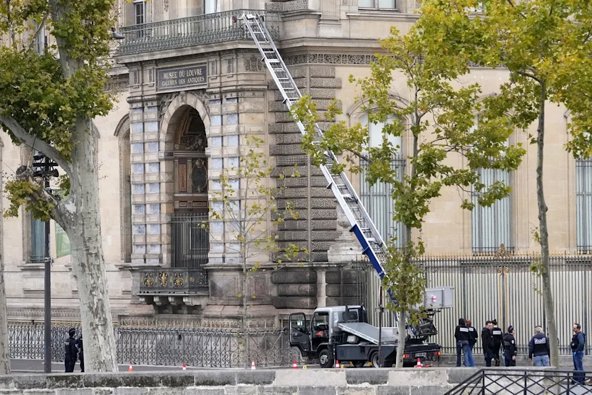
Jewel Heist at Louvre Museum: Two Suspects Arrested
A daring daylight “Louvre jewel heist” prompts arrests of two men and global scrutiny of museum security.
Quick Facts
- On 19 October 2025, four masked thieves broke into the Louvre Museum in Paris during opening hours, stealing eight high-value pieces of jewellery from the Galerie d’Apollon in just seven minutes.
- Investigators estimate the stolen haul is valued at approximately €88 million (about US $102 million).
- Two suspects in their 30s, from Seine-Saint-Denis, were arrested on 25 October 2025: one at Charles de Gaulle airport as he attempted to board a flight to Algeria, the other in the Paris region.
- As of now, none of the eight stolen items have been officially recovered, and investigators are still hunting the other members of the gang.
The Heist Unfolded
The robbery began at around 9:30 a.m. on the morning of 19 October. A stolen truck equipped with a furniture lift was parked outside the museum along the Seine. Two individuals dressed in high-visibility vests ascended via the lift to a balcony on the first floor of the Apollo Gallery. From there they entered through a window. In under four minutes they broke two display cases, grabbed the jewels and escaped on scooters.
The speed and planning have shocked security experts. The thieves seemed to act with military-style precision, using tools such as disc cutters. CCTV footage later revealed the descent on the lift and the getaway.
Arrests and Ongoing Investigation
Authorities say the two arrested men were already known to police. The arrests mark a crucial breakthrough, yet they raise as many questions as they answer. The public prosecutor, Laure Beccuau, warned that premature media leaks could hamper ongoing efforts, especially given the magnitude of the theft.
The investigation is being led by the Brigade de Répression du Banditisme (BRB) and the Central Office for the Fight against Illicit Trafficking of Cultural Goods (OCBC). Forensic teams have retrieved over 150 traces of DNA, fingerprints and hair samples at the scene.
While arrests have been made, the key task ahead remains: recovering the jewels and identifying the remaining gang members. Experts warn that once high-value items like these are dismantled, they may never be recovered intact.
Why Was the Louvre Targeted?
The choice of the Louvre museum was bold and strategic. The heist exposed multiple security weaknesses:
- Critical gaps in external camera coverage. A prior audit revealed that parts of the museum lacked surveillance.
- The chosen gallery houses some of France’s most historically significant jewels once owned by royalty. The sheer value and prestige of these items made them a target of opportunity.
- The timing — during open hours with tourists present — distracted guards, making it easier for the thieves to strike quickly.
In response, France’s President Emmanuel Macron called the robbery “an attack on our heritage,” underscoring the incident’s symbolic weight.
What Happens to the Stolen Jewels?
Investigators fear the eight pieces — including a diadem once worn by Empress Eugénie and an emerald-and-diamond necklace gifted by Napoleon I to Empress Marie Louise — may already be dismantled or recut to evade detection.
Criminologists estimate the chance of full recovery at about 50 %, given the potential for rapid disassembly and re-entry into the illicit gem trade.
Broader Implications for Museum Security
This high-profile theft signals a turning point for cultural institutions worldwide. It isn’t just about recovering at-risk gems — it’s about rethinking security protocols in museums with a global footprint. The incident highlights:
- Under-investment in surveillance and perimeter control. Museums built centuries ago may not be designed for modern security threats.
- The vulnerability of daytime operations with tourists when heavy equipment or vehicles can be used.
- The evolving trade in stolen heritage artefacts: once the items leave a secure collection, tracing them becomes exponentially harder.
As one security expert put it, recovering the identities of those who carried out the break-in is “almost always” possible, but recovering the actual items rarely is.
How many suspects are in custody?
Two men are currently in custody. Investigators believe at least four individuals carried out the raid.
Have the stolen jewels been found?
Not yet. One crown was deliberately dropped during the escape and found damaged. The remaining items remain missing.
Why did the thieves wear vests and use a truck with a lift?
They disguised themselves as maintenance workers to lower suspicion and used a furniture lift truck to access a balcony via a window — a tactic that exploited both façade architecture and daytime operations.
Looking Ahead
The Louvre’s reopening is contingent upon a secure review. The Galerie d’Apollon remains closed. Meanwhile, security reforms are now being fast-tracked. The French government plans additional resources for heritage protection and may mandate direct oversight of major museums’ security spending.
For the stolen items, the clock is already ticking. The longer they remain missing, the higher the risk that they will be dismantled beyond recognition. Each hour raises the odds that they’ll never be reclaimed in their original form.
Sources: Reuters ABC News CBS News Al Jazeera The Guardian






